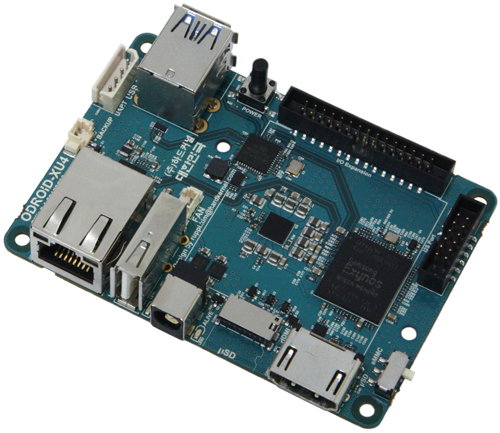ODROID XU4 setup

List of components
- ODROID XU4
- 16GB (or more) eMMc module
- eMMC reader
- micro-SD reader: check this link
- USB-UART Module Kit
- WiFi Module 3 (2.4Ghz only), good for outdoor use or WiFi Module 5 dual band 2.4/5Ghz, good for high-bandwidth
- DC plug cable- for onboard/portable power connection
- Ethernet cable
Setup Ubuntu
ODROID XU 4 supports both Ubuntu and Android, see the details on odroid page. Here we will discuss how to setup Ubuntu 16.04LTS
Flashing Ubuntu image
You can use either an SD card or eMMC. eMMC is recommended as it is much faster than SD card. (16GB (or more) is recommended).
You can flash either full ubuntu image with GUI ubuntu-16.04.3-4.14-mate-odroid-xu4-20171212.img.xz or minimal image ubuntu-16.04.3-4.14-minimal-odroid-xu4-20171213.img.xz. Minimal image will have much smaller size and faster boot and less overhead in general. Extract the downloaded image to obtain the .img image. Then, use Etcher to flash it to either SD or eMMC card.
You can extract the /xz image using
xz -d /path/to/image.img.xz
The previous images are bare images in the sense that you will have to install all required software in this tutorial yourself e.g. ROS, MAVORS, OpenCV, ...etc.
If you want a ready image with most of the required software in this tutorial, you can find a minimal image (no GUI) for your eyes in this link.
User account setup
After a fresh Ubuntu installation, it is recommended to setup a user account for easier handling in the future. The Ubuntu full image (that you download from ODROID repo) already comes with an account called odroid with default password odroid. However, the minimal image (or sometimes called Ubuntu server) is just a bare bones image, and you will need to do a lot of configuration to get it ready.
- In the minimal image, you can add a user account (call it odroid) using the following commands. You can do this by plugging a screen, keyboard/mouse, or through the console cable. If you use the console cable, login using the root account (user: root, password: odroid). Also make sure that your odroid is connected to internet via ethernet cable.
adduser odroid adduser odroid sudo apt-get update apt-get upgrade
- Also, add user to
dialoutgroup to access serial portssudo adduser odroid dialoutodroidis the account/user name.
Network Setup
It is recommended that you use static IP address if you plan to use ODROID via a WiFi network. This will reduce latency over wifi.
to set static IP address on full Ubuntu using GUI, check the this video
To set a static IP address on Ubuntu server (minimal image), do the following.
- add the following lines in the
/etc/network/interfacesfile.
add the followingnano /etc/network/interfacesauto wlan0 # the following will auto-start connection after boot allow-hotplug wlan0 iface wlan0 inet static address 192.168.1.131 # choose a static IP, usually you change the last number only for different devices netmask 255.255.255.0 broadcast 192.168.1.255 gateway 192.168.1.1 # your router IP dns-nameservers 8.8.8.8 wpa-ssid "wifi_name" wpa-psk "wifi_password"You will need modify 'wlan0' to match the wifi card number on your odroid once the wifi device is connected. Is possible that it changes when you change the wifi device.To check your wifi card number,ifconfig -a
Installing packages
Install ROS
To install ROS on ODROID or ARM-based single-board-computer, follow the instructions that is mentioned on the ROS websites. We assume that ROS Kinetic is used.
apt-get, don't execute
sudo apt-get install ros-kinetic-desktop-full
Instead, you execute,
sudo apt-get install ros-kinetic-ros-base
After installing ROS, you can install ROS packages that you need individually either by using apt-get or from source.
Install MAVROS
This package is used to interface MAVLink-based autopilots to ROS.
We will simply follow the well documented wiki on MAVROS github page. For simplicity, use the binary installation which is enough for most of the use cases.
Install OpenCV
Apparently, there are different ways to install OpenCV depending on the OpenCV version and your Python version, if you want to use it with Python. There are plenty of tutorial to follow and you can choose the one that suits your requirements. Normal procedures for general Ubuntu can be used. Here, one way is mentioned to install certain opencv version from source. Use the following shell commands to install OpenCV,
### INSTALL OPENCV DEPENDENCIES ###
sudo apt-get install build-essential checkinstall cmake pkg-config yasm libtiff4-dev libjpeg-dev libjasper-dev libavcodec-dev libavformat-dev libswscale-dev libdc1394-22-dev libxine-dev libgstreamer0.10-dev libgstreamer-plugins-base0.10-dev libv4l-dev python-dev python-numpy libqt4-dev libgtk2.0-dev libavcodec-dev libavformat-dev libswscale-dev libtbb2 libtbb-dev
You can choose your suitable opencv versoin (check opnecv website) and execute the following
### GET OPENCV SOURCE ###
cd ~
wget http://sourceforge.net/projects/opencvlibrary/files/opencv-unix/2.4.9/opencv-2.4.9.zip
unzip opencv-2.4.9.zip
rm opencv-2.4.9.zip
cd opencv-2.4.9
### BUILD AND INSTALL OPENCV ###
mkdir build
cd build
cmake -DCMAKE_BUILD_TYPE=RELEASE -DCMAKE_INSTALL_PREFIX=/usr/local -DWITH_OPENGL=ON -DWITH_V4L=ON -DWITH_TBB=ON -DBUILD_TBB=ON -DENABLE_VFPV3=ON -DENABLE_NEON=ON ..
make
sudo make install
References
Here is a video for reference which explains how to install OpenCV on ODROID XU4.
Thanks for reading!
Happy developing!